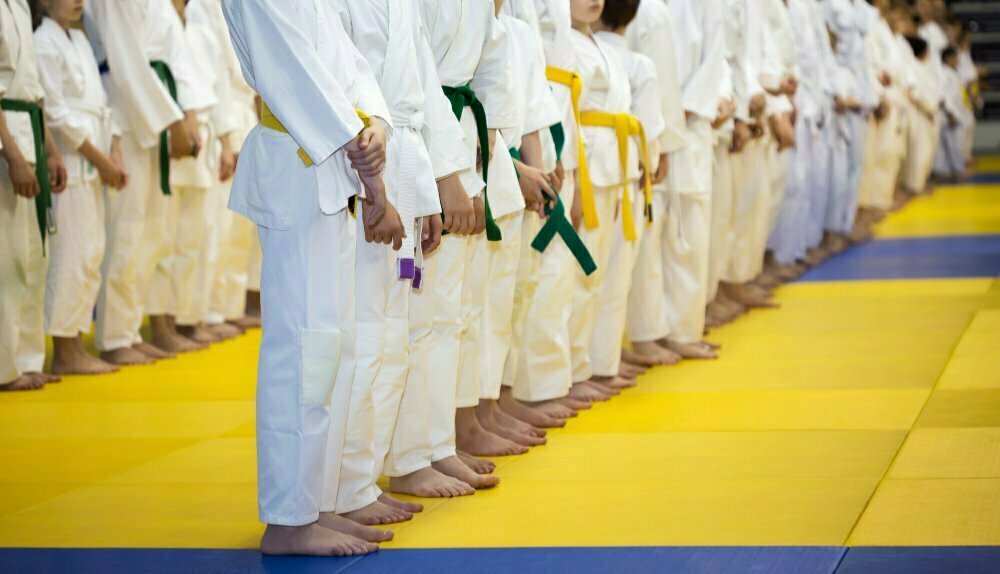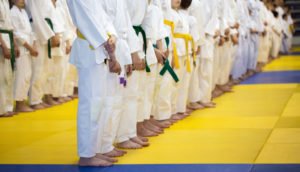
Why the martial arts

By Ravil Sayfullin/Shutterstock
Millions of people World Wide, both past and present, practice the martial arts, and although the reasons for participating may have changed slightly over the centuries the fundamentals remain largely unchanged.
The Benefits
Practicing any form of martial art serves to condition the body & mind, and when done with commitment also the soul instilling self-discipline, humility, and respect into the participant. Additionally, but it is also a great form of self-defence and can help with confidence issues.
Brief History
Martial arts have been around for at least 4000 years, possibly originating in its currently better-known styles in China who’s early history was turbulent to say the least then self-defence was a necessity for survival for many and as time progressed, therefore, martial arts were adopted by the military.
Today, all armed forces and most law enforcement agencies are trained in some form of hand to hand combat, for example, the Israel Defence Force (IDF) and the Israeli Security forces use Krav Maga, while the Korean police have adopted Taekwondo and Hapkido. The military and much, if not all, the law enforcement in Japan use the martial art of Taiho-Jutsu, translated simply means “arrest technique” a grappling and striking art employing Judo and Karate style moves. The Russian police, military and special forces (Spetsnaz) are trained in Sambo, a mixed martial art, borrowing techniques from many other fighting arts.
For those of us who are not members of a country’s special forces or law enforcement joining the local martial arts clubs allows us to enjoy them as a sport, a means of getting and staying in better shape or for self-defence; whichever you choose you get a bit of all three. But which on the multitude of martial arts on offer should you choose?
Different Styles For Different People
There are so many martial arts to choose from and some people are in a more fortunate position than others in this respect. Some smaller towns may literally have just one option and others that reside in larger towns cities may have many options. So at a fundamental level, it may be a case of taking what’s on offer. Only having the one club is not an altogether terrible situation, as most clubs will offer a little self-defence alongside a sporting element and it goes without saying that any activity that results in you moving around is only going to increase your levels of general fitness. Martial arts or self-defence club also allows you to meet new people, and the friendships developed in these clubs can last a lifetime. Over time a level of trust and mutual respect comes from training in this arena that breeds very strong bonds.
When choosing which arts might best fit you and your lifestyle, you might want to consider a couple of points.
Your general health for instance – if you suffer from a bad back, or have neck-problems, then a grappling art such as Jiu-jitsu or Judo (where your competitors are looking to throw you or wrap their arms around your neck to choke you), may possibly be an unwise choice. Your base level of fitness should also be considered, although practicing a martial art can only help ensure your fitness improves – jumping into an MMA (mixed martial arts) ring is extremely arduous and maybe a step too far as a starting point.
Further you must also consider your work life and unfortunately for most people work has to take priority. Should you be customer facing, turning up with two black eyes after a night practicing full contact Karate or an evening’s training in the boxing ring does not, really, project the appropriate image.
So, which martial art do you choose? Walking into any old club and signing up for some classes is certainly one way of becoming disillusioned very quickly. You first need to understand that not all arts are the same, some of you may be thinking that yes, they do have different names, Jui jitsu, Karate, Judo, Aikido but they are all the same, aren’t they? Well No in a word and below we have outlined the basic differences.
Breaking them Down into Categories
Martial arts can be placed in categories or groups:
Striking Styles e.g. Boxing, Karate and Wing Chun’
Grappling Styles e.g. Jiu-jitsu, Judo, Aikido and of course wrestling
Self Defence orientated Styles such as Krav Maga and American Kenpo karate.
These all differ massively both in terms of the training emphasis and the levels of conditioning and flexibility you need.
So (assuming you have a choice) You need to decide what it is you are looking for, and what are you looking to achieve?
Are you willing to dedicate yourself to something long term? Most martial arts possess a ranking system, so is becoming an advanced student or an expert and achieving a black belt something you can see yourself doing? This takes years of dedication and if this is your goal then you probably won’t want to take up a pure fighting style such as boxing.
Are you looking to enter the sporting arena and excel in competition against other competitors? Some martial arts and fighting styles are more sports orientated than others, while some like boxing and wrestling are almost totally sports orientated.
Should you opt for self-defence you need, to understand that a self-defence art is not necessarily teaching you to fight in a ring or undergo a structure grading system, although some do have an admittedly lesser emphasised element of these in them. To help you decide it is useful to consider what fighting and self-defence mean:
Competing or Defending
Most styles that emphasise Competing are generally teaching within the confines of the rules of their sport. For example, Judo & Jiu-Jitsu players are not drilled with striking techniques, as the whole emphasis of their discipline is to grapple the opponent to the deck and gain a pin or submission. Of course, they can hit in an outside altercation, but they aren’t as adept at it as for example, a boxer is.
Traditional Boxers, on the other hand, are exclusively taught and drilled in punching techniques – Hooks Jabs Uppercuts etc. Kick Boxing extends the remit by including kicking and elbow techniques but again the emphasis is on fighting standing up. Most will have some rudimentary grappling knowledge – if only from their playground escapades but they won’t be as adept at it as a Jiu-Jitsu player if they get into a fight which ends up on the floor.
So, all things being equal a boxer should easily claim victory in a stand-up confrontation and a Jiu-Jitsu player should easily claim victory in a fight that goes to the ground. Thus, Boxing and Jiu-Jitsu are as effective as each other, and the outcome will depend on the circumstances, largely where the confrontation takes place. But where does that leave a self-defence practitioner?
Self-defence practitioners try to bridge the gap between the two, and apart from a gifted few will never be as good at punching as a boxer or as good at grappling as a Judo player. This style of training is largely no hold barred and strikes such as knees, elbows, eye pokes, chops and even headbutts are included. Grappling includes rudimentary techniques, chokes, armbars, rear hammerlocks, etc. This does give a self-defence practitioner a slight edge if facing an opponent of similar skills and physical ability who is an exponent of either of the other two disciplines.
Self-defence training teaches one to react – with instinctual speed to any of several potential attack scenarios including strikes grabs and bear hugs etc. The rationale for this is the 3-second rule which is the average duration of most street confrontations. The aim is to react retaliate hard and get away from the scene as quickly as possible. Self-defence is not about standing around admiring your handiwork and if a confrontation that has escalated beyond this it will become more of a duel and test of skill which would favour the sports practitioner. This will be because they will have trained for a duration encounter i.e. Boxing rounds typically last 3 minutes and a Judo match 5 minutes. People dedicated to these will generally have better conditioning that a self-defence practitioner.
The good news if you are a self-defence practitioner is that you are highly unlikely to face a highly skilled striker or grappler – as they don’t tend to go around looking for fights, and similarly a self-defence orientated person has been trained to defend and will have learned diffusing strategies which often prevent a fight starting in the first place.
Therefore your choice you will depend to a degree on your fitness level and the amount of time you are prepared to devote to it. Below are a few styles for you to consider:
KARATE
Kyokushin or The Ultimate Truth
Full contact style of Karate. Typically, it displays physically strong fighters and is sport oriented. Generally, self-defence in these clubs tends not to be practiced and remains in only a few, and does not tend to form a part of the grading system. Those that practice Kyokushin Karate are full contact fighters and there is an argument that fighters don’t require self-defence to the same extent as other lesser contact sports
Shotokan
Sports based Karate and for the most part is points based and not full contact. Is linear in both defence and attack. Any self-defence taught appears to be extremely basic unrealistic and far from all-encompassing. Shotokan punching and evasion in an arena, with plenty of room to move is ok, put the practitioner in a more restricted space and they are going to struggle. Anyone who can punch as the Shotokan practitioner can will, however, maintain an advantage, however, his/her defence against looping hooks/roundhouse attack is limited. Shotokan trains basic Kata (forms) and sparring. An advantage is that the Shotokan practitioner has only a few techniques and they tend to be good at them. Should the Shotokan practitioner have the time and the willingness to use a pre-emptive strike, they could end the fight before it really began. In summary, a reasonable fighting art, a great sport but lacking ingenuity when it comes to self-defence
AIKIDO
Recognised as a grappling art, but not in the same way as Brazilian Jiu-jitsu or Judo. Aikido utilises evasive movements which is considered to work better against a focussed ferocious attacker. The Jiu-Jitsu practitioner will utilise his own body weight and force a takedown on an opponent, for example by way of a double leg takedown, whereas the Aikido practitioner simply uses the attackers’ own momentum to take them down. The BJJ fighter is attacking where the Aikido fighter is using defence. It is a calm non-aggressive beautiful art. Aikido cannot be labelled as either a sport or a self-defence system, however an Aikido practitioner I was fortunate to converse with a high-level Aikido practitioner who stated that the aim is not to win a fight, he is not looking to attack, he is only trying not to be defeated, and it if that is the outcome, then he has won. There are no points to score in a non-sport martial art – Aikido is the art of not getting hit, evasion is a wonderful defence.
AMERICAN KENPO
A 154-technique self-defence system if taught only in what Kenpo teachers term “ideal phase” techniques. The ideal phase techniques are taught not only for self-defence but to illustrate the principles of the art. Almost any conceivable non-weapon attack is captured in this system of self-defence techniques. Black Belt Magazine reported that Ed Parkers American Kenpo is the most complete self-defence art ever developed. It did not state however, that is was the best fighting art. It is a wonderful art with many colourful characters but it should not really be relied upon as a great fighting art – there are other arts that are more appropriate for the fighting arena. The American Kenpo practitioners are amongst the most knowledgeable martial artists of all, with a tremendous amount of education required in the art to be recognised as a full instructor, of 3rd Dan or above. If you are searching for an art that can fit into your home/work/leisure lifestyle, Kenpo can be a great fit and offers longevity as practitioners tend not to suffer serious injuries. There are going to be knocks and bruises of course, but the martial artists themselves take pride in their ability to control their striking. They are known to be able to throw a strike with 100% power and aggression, yet only just touch the skin of their opponent. This takes years of practice and great control but the American Kenpo community display this as control is an important requirement of their grading standards. The system does require the attackers to be compliant due to the lethality of some of the moves which doe not promote a spontaneous reaction, so this could be viewed as a negative
WING CHUN
For the most part is recognised as a self-defence martial art, with the emphasis being on simultaneous defence and counterattack by interception of the attackers’ weapon, economy of motion in every technique (which incidentally is also one of the key principles of American Kenpo), and centreline defence and attack. Economy of motion requires point of origin striking which is simply striking and blocking from where-ever the hand lies. The Wing Chun practitioner develops excellent touch sensitivity and reflexes, this is down to the Chi Sau (Sticky Hand) training with a resistant partner. Trapping of hands which immobilises the opponent is trained during Chi Sau. The Wing Chun exponent has simplicity, directness, practicality, economy of movement and minimum use of brute strength as an advantage. It is a very effective close-range art, especially against an unskilled attacker.
WADO RYU
As opposed to other Japanese Karate styles, Wado Ryu employs a more yielding personality, incorporating both soft and hard energy. Unlike some Japanese styles, Wado Ryu uses what is termed “body shifting” to deflect a strike as opposed to meeting strength with strength, power with power. This can cause the attacker to lose their balance, and the Wado Ryu practitioner to seek a take-down, which they possess in their system. Wado Ryu is a sport based martial art that utilises a higher stance, similar to American Kenpo and unlike Shotokan which employs a very strong low and wide stance. This allows the Wado Ryu practitioner to move more easily and more quickly and in a non-linear direction. Wado Ryu, like Shotokan, is an excellent sport. Self-defence in Wado Ryu is limited, however, it is recognised by many as being more appropriate for the street than Shotokan.
KRAV MAGA
An eclectic art, developed by combining the philosophies and most effective techniques from various martial arts and is utilised by the Israeli special forces. It is not a sport, but purely a very effective self-defence system. It is recognised as a martial art quite the same as American Kenpo, which I also believe is purely self-defence, but does not practice forms as the likes of American Kenpo, Shotokan or Wado Ryu. Krav Maga teaches basic self-defence techniques, through scripted predetermined scenarios. The notable difference is the attitude of the Krav Maga practitioner, which is displayed in only wanting to survive, and looking for the attack to be over a quickly as possible, whereas in American Kenpo the practitioner is looking to insert a prefix or suffix what could be viewed as unnecessary moves – this is more in line with it being an art – the Krav Maga practitioner will use the same weapon, a knee strike or elbow strike over and over again, this attitude will finish the fights more efficiently than an art that employs two moves when one may do
BRAZILIAN JIU JITSU
A grappling art which first came to international prominence during the first few Ultimate Fighting Championships, where, in November of 1993, the fighters from an array of different martial arts came together to compete in full contact, almost “anything goes” bouts, Royce Gracie was the sole BJJ competitor and representing the Gracie family he defeated three opponents all of whom significantly outweighed him. BJJ successfully promotes the concept that a small fighter can defend themselves against a much stronger and larger opponent, by employing proper technique. BJJ fights are almost always going to take place on the ground. The BJJ practitioner will attempt to apply joint locks and/or numerous chokeholds to defeat an opponent. BJJ is a very adequate self-defence system, certainly against single person attacks. It is an excellent sport that allows the fighters to train and compete using all the BJJ techniques with 100% intent and resistance without fear of being badly hurt. BJJ is recognised as being one of the most effective fighting arts, yet also remains one of the safest, as clubs do not teach striking. BJJ is certainly suitable for either children or adults.
JUDO
A grappling art, like BJJ, however, the fights will commence in the standing position. Judo practitioners aim to throw the other competitor and train many different throws and take-downs. Pinning an opponent to the ground is a means of scoring points in a Judo match, as is throwing or tripping an opponent. The pinning of the opponent signifies control. A Judo player, as in BJJ, is able to use full intensity when either training or in competition, which develops spontaneity and because training partners are truly resisting and not simply complying, which allows the practitioners to gain a much better understanding of what really works and what does not. Judo is an Olympic sport with different weight divisions. It is an excellent sport for children to be involved with. As with BJJ, Judo is not a striking art, therefore damage to the face is unlikely
TAEKWONDO
A striking art which emphasises its kicking techniques. It was adopted by the Olympics for the 2000 summer games in Sydney. It is an eye-catching sport with the competitors demonstrating speed, power and exciting head height spin-kicking. High-level practitioners are very athletic.
As a self defence system, most martial artists would agree that the art significantly lacks the appropriate skills, however it is hard to argue that it is not a fantastic sport and serious injury is rare. It is an extremely popular art and suitable for children and adults alike.





